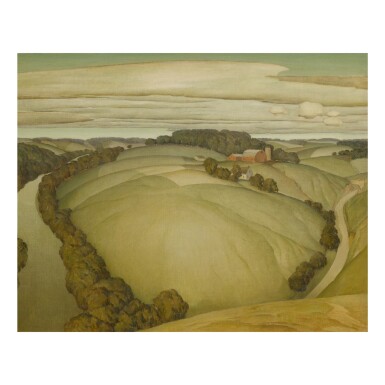American Art
American Art

MARVIN DORWART CONE | RIVER BEND #4
Auction Closed
November 19, 04:22 PM GMT
Estimate
400,000 - 600,000 USD
Lot Details
Description
MARVIN DORWART CONE
1891 - 1965
RIVER BEND #4
signed MARVIN/CONE (lower left); also signed again and titled RIVER BEND #4 (on an original label affixed to the backing board)
oil on canvas
24 by 30 inches
(61 by 76.2 cm)
Painted in 1938.
This painting will be included as no. 1938.001 in Joseph S. Czestochowski's forthcoming catalogue raisonné of the artist’s work to be published by International Arts® at www.catrais.org. We wish to thank him for cataloguing this lot.
The artist
Estate of the above
Cedar Rapids Country Club, Cedar Rapids, Iowa
Sold: Jackson's Auctioneers & Appraisers, Cedar Falls, Iowa, November 29, 2000, lot 147
Hirschl & Adler Galleries, Inc., New York
Acquired by the present owner from the above, 2001
Joseph S. Czestochowski, Marvin D. Cone: Art as Self-Portrait, Cedar Rapids, Iowa, 1989, no. 335, p. 232, illustrated p. 115
Joseph S. Czestochowski, Marvin D. Cone and Grant Wood – An American Tradition, Cedar Rapids, 1990, no. 75, illustrated p. 71
Marvin D. Cone’s River Bend #4, was painted during the waning years of the Regionalist movement; eight years after Grant Wood’s meteoric success with his American Gothic at the Art Institute of Chicago, five years after the second Stone City Art Colony, Iowa, and, and three before the onset of the Second World War. Throughout the decade of the 1930s, both Cone and Wood were distinguished community artists, familiar figures among contemporaries, and frequent participants in numerous national invitational and competitive exhibitions. They were lifelong friends, shared more than ten joint exhibits in the 1920s, key organizers at Stone City, and often sketched outdoors with other artists. River Bend # 4 is one of less than fifteen river bend subjects created between 1935 and 1940. These paintings depict the countryside surrounding the Cedar and Wapsipinicon River Valleys. Few others remain in private hands.
While both Wood and Cone were captivated by design, line and color, they were also very different. Wood preferred an Arcadian escapist perspective at a time of social and economic upheaval. Unlike his close friend, Cone did not consider himself a Regionalist nor seek to define an American aesthetic; rather, he sought to paint for himself and give voice to his inner feelings. The Stone City countryside in the 1930s provided the setting for well-known paintings by both artists. Each year Cone and his family spent the summers there at the historic Green-Nissen Mansion, home of the distinguished writer Paul Engle and his wife Mary Nissen.
Like his cloud and landscape paintings from the 1920s, the River Bend subjects were an immediate success. Though part of a larger group, each work from the series is individual. Each is a complete thought, showing no relationship to either earlier or later works. In every case, they are finely balanced, with striking color harmonies that range in the earliest landscapes from a precise hard-edge effect with dark tonalities to a softly contoured landscape with light tonal light effects. These works typically developed from very small pencil idea sketches that were then re-examined directly with charcoal on the canvas. Consistently he strove for a collective portrait, not geographic specificity. The early works are characterized by flattened color masses that approach a semi-abstract design. Other slightly later works are considerably lighter in color and have an overall softness. A critic for the Chicago Tribune described these as "smooth, tranquil, polished, and exquisite...The drawing in them is as gentle and restrained as it is accurate" (as quoted in "Prof. Marvin Cone Believes That Paintings are Experience Records," Coe College Cosmos, April 30, 1936, p. 3).
In River Bend # 4, as others in the series, the colors are subtle with gradual tonal gradations, evocative in their suggestion of light. Cone uses a complex layering of forms that gives depth to the fields, trees and rolling hills in the landscape and clouds in the huge lateral expanse of sky. Human presence is minimized, and picturesque sentimentality does not exist. The horizon extends to the edge of the picture, serving to heighten the viewer's awareness of what is beyond the limitations of the canvas. While these works are a powerful statement about the mysteries of nature, they are also extremely personal in their evocation of solitude and tranquility. In these landscapes, Cone truly created a vision safe from the changes of time, a quality of transience in permanence. “The artist does not set out to imitate nature," Cone remarked. "Art traces an abstraction and makes it audible or visual. It symbolizes the whole of life” (as quoted in Cedar Rapids Gazette, January 19, 1938, p. 15, and May 26, 1938, p. 8).
Contemporary critics praised the River Bend paintings for their bold geographic form and their modern aesthetic. Perhaps the poet and his close friend Paul Engle best summarized Cone’s achievements when he said in 1960, “Marvin Cone dramatized space...He stares at the world with his hands...He has the painter’s second sight, the form seen once, then again after the imagination has redefined it" ("Portrait of the Artist as Neighbor," Marvin Cone, A Retrospective Exhibition 1938-1960, Iowa City, Iowa, 1960, n.p.).
© Joseph S. Czestochowski
